Monaco hosted Paris Saint-Germain at Stade Louis II on Friday in a Ligue 1 clash. Having gone into half-time trailing the Ligue 1 leaders by two goals, Monaco managed to make a second-half comeback to win this game 3-2.
Les Monégasques are now just four points behind Les Parisiens on the league table, with both sides having played 11 games at this stage of the campaign.
In this tactical analysis piece, we’ll provide some analysis of how both PSG and Monaco set up on and off the ball for this fixture and we’ll analyse the key aspects of these two teams’ tactics from Friday’s game and how they influenced the outcome, with Niko Kovač ultimately getting one over on Thomas Tuchel this past weekend.
Lineups and formations
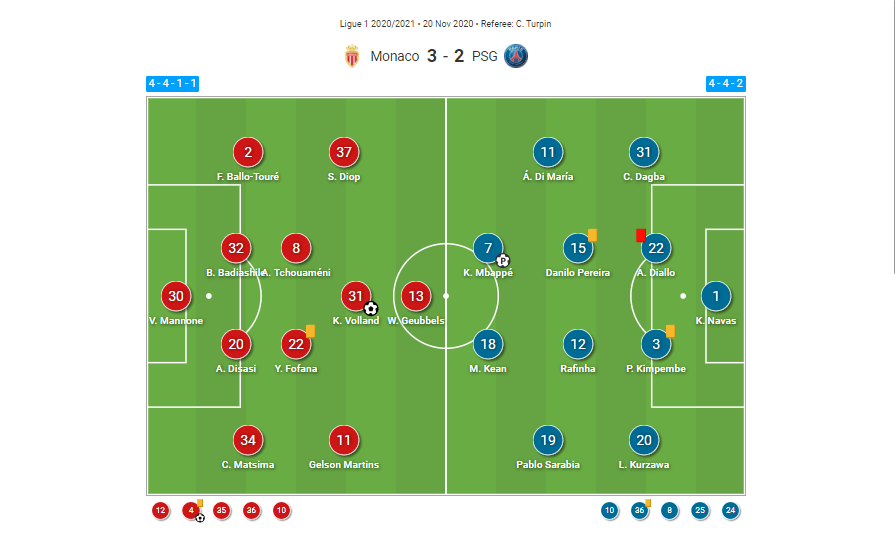
Starting with the home side, Monaco played in a 4-4-1-1 shape for this game, with ex-Arsenal stopper Vito Mannone playing between the sticks and a back-four consisting of left-back Fodé Ballo-Touré, right-back Chrislain Matsima, and the centre-back duo of Benoît Badiashile on the left and Axel Disasi on the right.
Youssouf Fofana and Aurélien Tchouaméni started in central midfield, with Sofiane Diop on the left and Gelson Martins on the right, while Kevin Volland started in the ‘10’ position just behind centre-forward Willem Geubbels.
At half-time, Cesc Fàbregas replaced Geubbels and took up the ‘10’ position – a move that saw Volland push up into the centre-forward position – and Caio Henrique replaced Ballo-Touré at left-back. Then, in stoppage time, Florentino Luís replaced Tchouaméni in central midfield and Stevan Jovetić made a cameo appearance, replacing Diop.
As for the away side, PSG lined up in a 4-4-2 formation for Friday’s Ligue 1 clash with Monaco. Keylor Navas started in goal for the league leaders, while right-back Colin Dagba, left-back Layvin Kurzawa, right centre-back Abdou Diallo and left centre-back Presnel Kimpembe started just in front of the Costa Rican ‘keeper.
Rafina and Danilo Pereira started in central midfield for PSG, while Ángel Di María started on the right side of midfield and Pablo Sarabia started on the left side of midfield. Ahead of them played Les Parisiens’ strike duo of Kylian Mbappé and Moise Kean.
Tuchel made use of one more substitute than Kovač did in this one. Firstly, Neymar replaced Di María in the 60th minute and just under 10 minutes after the German coach made that change, Mitchel Bakker replaced Kurzawa, Leandro Paredes replaced Pereira and Kays Ruiz-Atil replaced Mbappé.
They went on to make one more change in the 85th minute as Alessandro Florenzi, who is on loan at the Paris club from Serie A side Roma, replaced Rafinha.
PSG’s tactics off the ball
Next up, we’re going to provide some analysis of the tactics that PSG used off the ball in Friday’s game. Tuchel’s side generally tends to press aggressively, high up the pitch and that was no different for this clash with Monaco.
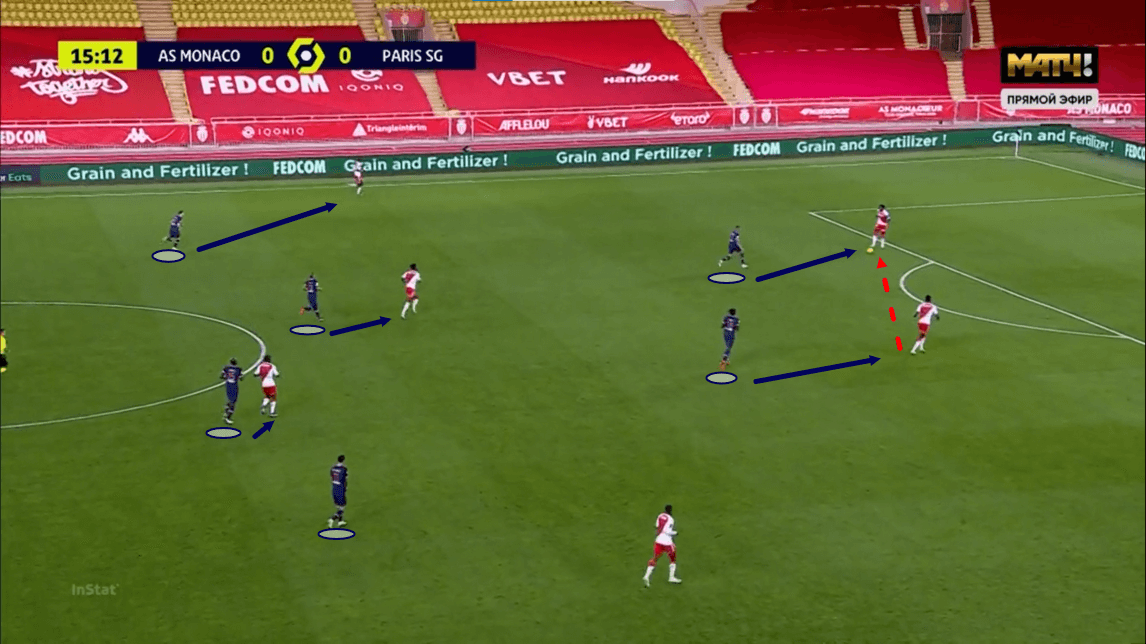
PSG defended in a 4-4-2 and pressed right from the front in this game. The image above provides us with a typical example of how PSG pressed Monaco during their build-up last Friday.
Just before this image was taken, Badiashile played the ball to his central defensive partner Disasi and as this pass was played, it triggered PSG striker Mbappé’s press.
Kean maintained access to Badiashile as Disasi controlled the ball here, essentially making it difficult for the centre-back to play it back to his central defensive partner, while both of PSG’s central midfielders marked both of Monaco’s two central midfielders quite tightly.
Rafinha and Pereira always stuck to Monaco’s central midfielders very tightly and this was successful in helping the away side to prevent Monaco from playing through the centre of the park. This resulted in PSG’s defensive shape appearing almost like a 4-1-3-2 at times because of how their central midfielders would follow the Monaco midfielders’ movement.
Additionally, as Disasi controlled this pass, Sarabia moved closer to Matsima, maintaining access to the right-back in case Monaco attempted to play out through him. However, Di Maria, on the opposite wing, didn’t get as tight to Ballo-Touré, as the right centre-back would have to play a long pass to find him, which would give PSG time to re-adjust.
These defensive tactics were successful in preventing Monaco from building attacks from the back via either of their central midfielders or their full-backs and helped the away side to win the ball high up the pitch on a couple of occasions when Monaco ended up playing passes into risky areas.
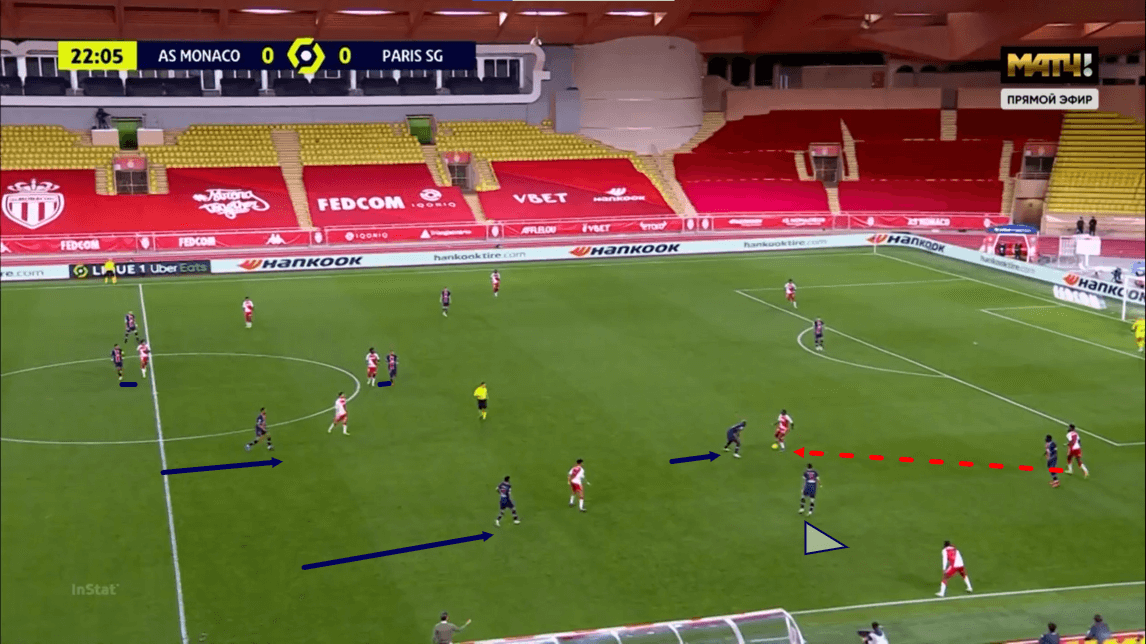
On a couple of occasions in this game, Monaco did manage to play the ball into central midfield, thus managing to play past PSG’s first line of defence – the two centre-forwards. On these occasions, as the image above demonstrates, PSG’s defenders got tighter to the Monaco players positioned just ahead of the midfield, to try and prevent the hosts from going on to play through midfield and exploit the space in between PSG’s midfield line and backline.
Up until this point, PSG’s backline remained deep and didn’t mark the opposition tightly, instead opting to hold their position, but as the ball was played into midfield by Monaco, PSG’s backline advanced into these positions here, giving Monaco’s near attackers less space in the process.
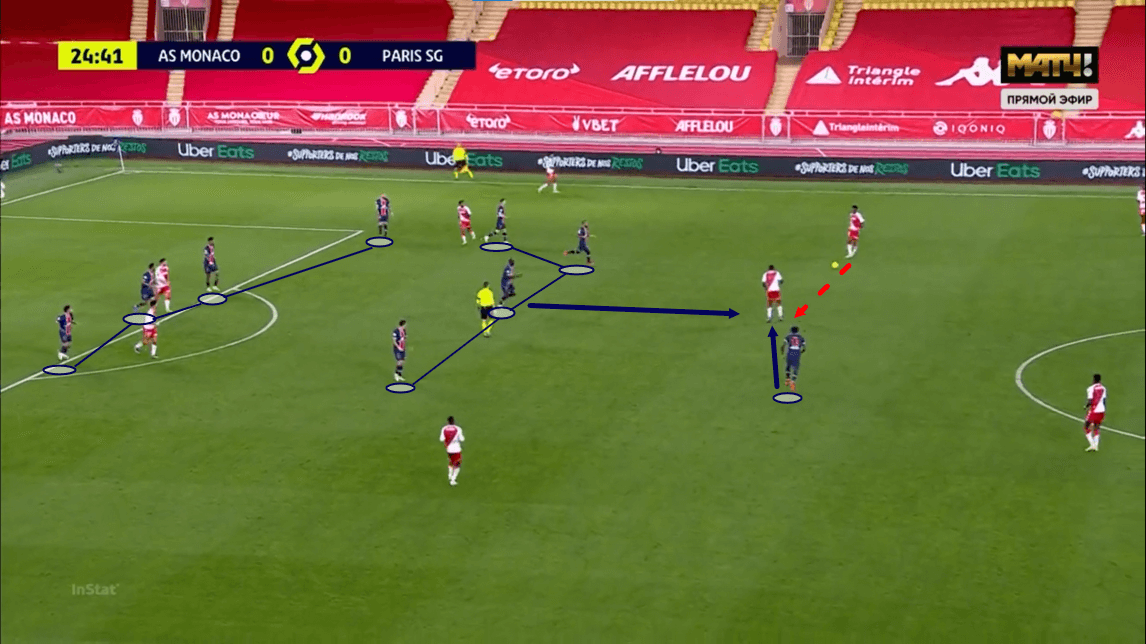
This next image shows us how PSG shaped up when defending deeper areas of the pitch, during a more advanced Monaco attack.
Both their backline and midfield line got horizontally compact and vertically compact to one another, while one of their centre-forward’s, Kean, also dropped deep in these scenarios, leaving only Mbappé and the threat of his pace on the counter alone up top on the Monaco defenders’ shoulders.
Especially in the first half, this was successful at limiting Monaco’s options in the final third, especially the central options, and often forced them to play the ball out wide – an area in which PSG were happier for them to have the ball than the centre.
On this particular occasion being shown in the image above, as the ball was being played into right central midfielder Fofana, Kean pressed the receiver from behind, as did Pereira from the midfield. The two players were successful in dispossessing the 21-year-old and springing a counter-attack for Les Parisiens, demonstrating one of the ways in which this block was effective in winning the ball back for the visitors.
Monaco’s tactics off the ball
Monaco’s defensive tactics weren’t very dissimilar to PSG’s defensive tactics but there were some notable differences in how Monaco pressed the league leaders.
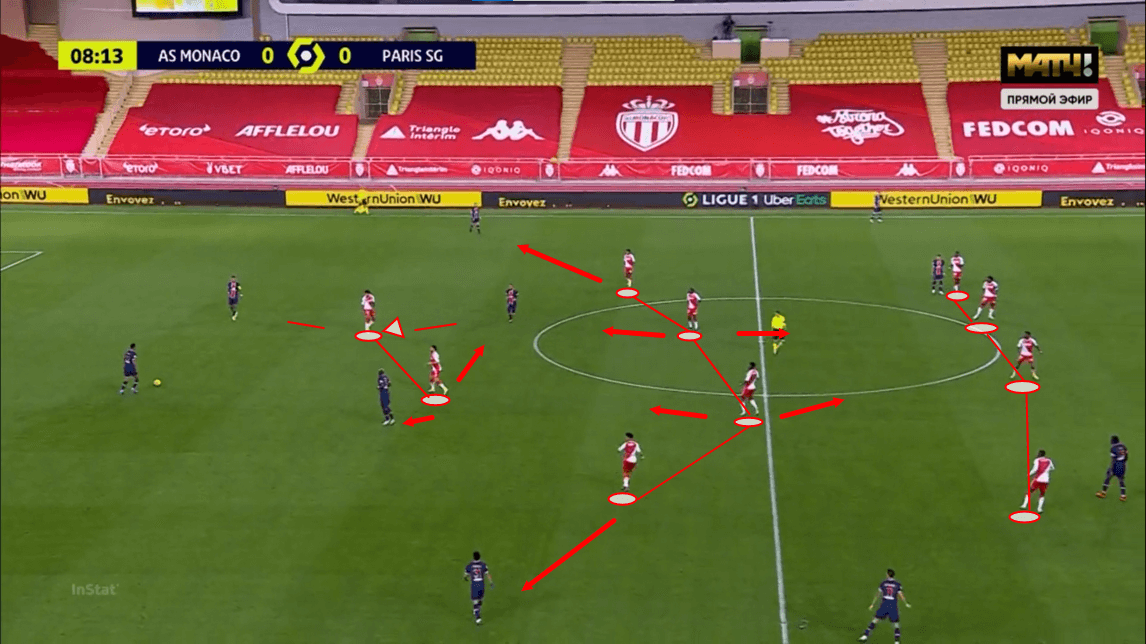
Firstly, as we can see here, Monaco’s general defensive shape was very similar to PSG’s. The striker was slightly more advanced than the ‘10’ and put some pressure on the backline while keeping the ball-far PSG midfielder in their cover shadow. Meanwhile, the ‘10’ usually got tight to the nearest PSG midfielder to the defender on the ball. We can see this is the case in the image above.
Les Monéasques’ back-four and midfield four both stayed fairly narrow. The central midfielder closest to the PSG midfielder not being marked by the ‘10’ would usually attract attention from the nearest Monaco midfielder to him, while the other central midfielder would drop deep, ensuring that large gaps didn’t open up in between the lines.
This resulted in Monaco’s defensive shape looking like more of a 4-1-4-1 at times and it differed from PSG’s defensive tactics that saw both of their central midfielders marking Monaco players tightly and could result in gaps opening up in between the lines which Tuchel’s side usually looked to the backline to fill.
Monaco’s wide midfielders usually remained quite central and only pressed the PSG full-backs out wide after the ball was played out to them. At the same time, Monaco’s near full-back would get tight to PSG’s near winger and this is how Monaco tried to stop PSG from progressing the ball via the wing.
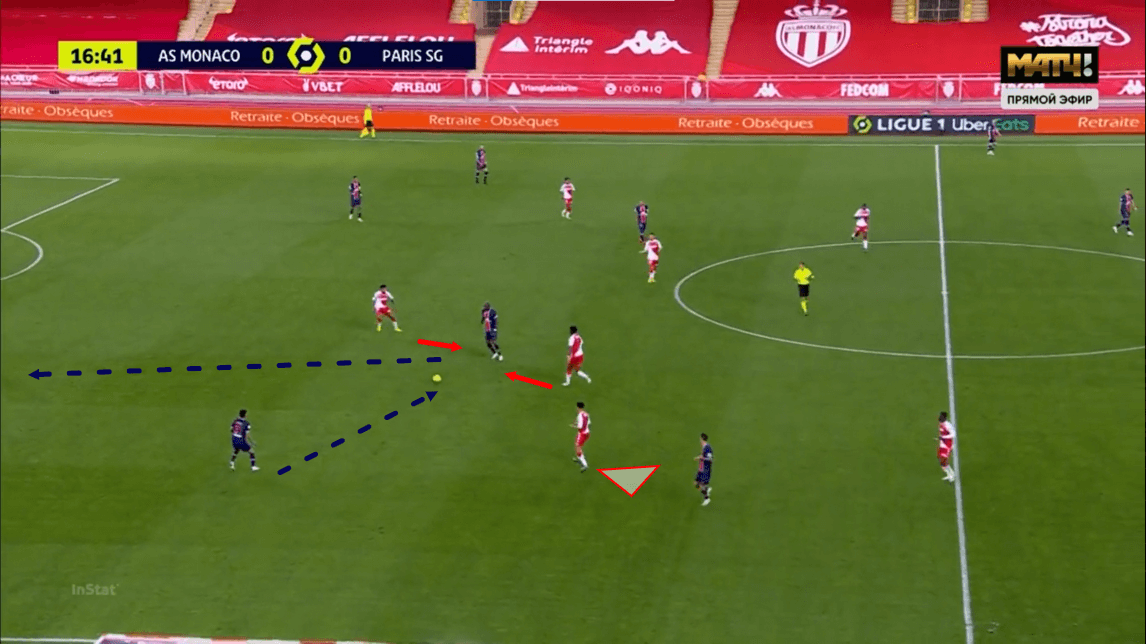
This next image shows us an example of a situation where PSG right-back Dagba has played the ball into Pereira in midfield but as the Portugal international prepares to receive the ball, he is pressed by both the near central midfielder and the striker from the other side. They liked to double-up on PSG players when they received the ball in midfield, with either one of the attackers or one of the wide midfielders often joining the central midfielder in pressing.
This provides an example of how Monaco’s defensive tactics worked, with their shape resembling a 4-1-4-1, as discussed, in this particular image. Tchouaméni’s pressure was good enough to prevent Pereira from turning and this resulted in PSG failing to build past Monaco’s midfield line as Pereira was forced to play the ball back to Diallo at right centre-back.
PSG’s central midfielders struggled to turn on the ball when receiving it deep throughout this match as a result of this pressure from Monaco’s midfield, while the home side was effective at winning the ball back high up the pitch thanks to their defensive tactics and this then ended up being a useful offensive tool for them as they enjoyed counter-attacking opportunities aplenty in dangerous positions.
PSG’s tactics on the ball
It was difficult for PSG to build out from the back in their 4-4-2 shape throughout this game, both via the centre of the pitch and via the wings, as discussed, due to Monaco’s defensive tactics.
They struggled to address their issues during the contest and even the introduction of Paredes failed to make much of an impact as Monaco deployed a well-organised press.
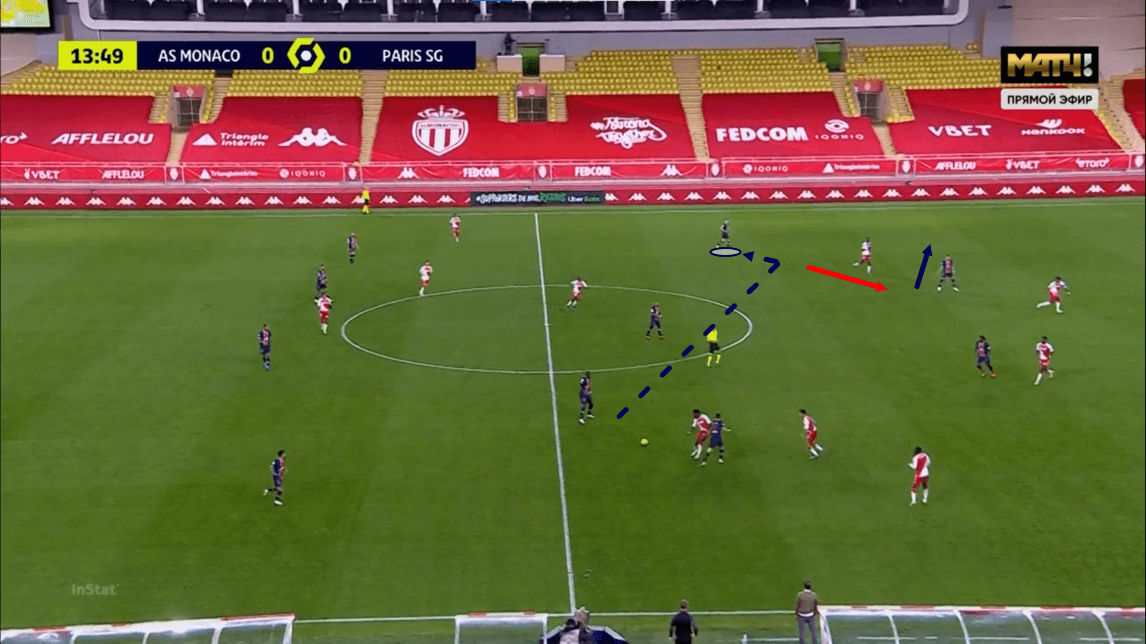
However, PSG did still demonstrate some interesting and effective offensive tactics, one of which can be seen in the image above. Les Parisiens were often forced to go long from the back and one of the balls that they typically played when forced to go long was the long-ball out to left midfielder Sarabia.
We can see Pereira receiving the ball in midfield here and as this particular passage of play moves on, the 29-year-old on-loan from FC Porto plays that long-ball out to Sarabia, who moves out even wider, allowing his side to use the full width of the pitch.
This was an effective tactic as it allowed PSG to double-up on the Monaco right-back with Sarabia and Mbappé, who usually occupied the left centre-forward position.
As we mentioned previously, Monaco’s backline was quite narrow off the ball and as a result, this often allowed Sarabia to enjoy plenty of space out wide. When the Spaniard then received the ball out wide in situations like this one, he forced Matsima to make a decision between moving out to press him or staying narrow to provide extra support to the centre-back in dealing wit Mbappé, who would often move into the channel between the centre-back and full-back.
As a result, either Sarabia would be allowed space to cross or Mbappé would get into space which made him an easy passing option for Sarabia. PSG managed to create multiple opportunities by playing the ball out to Sarabia, who would team-up with Mbappé to cause problems.
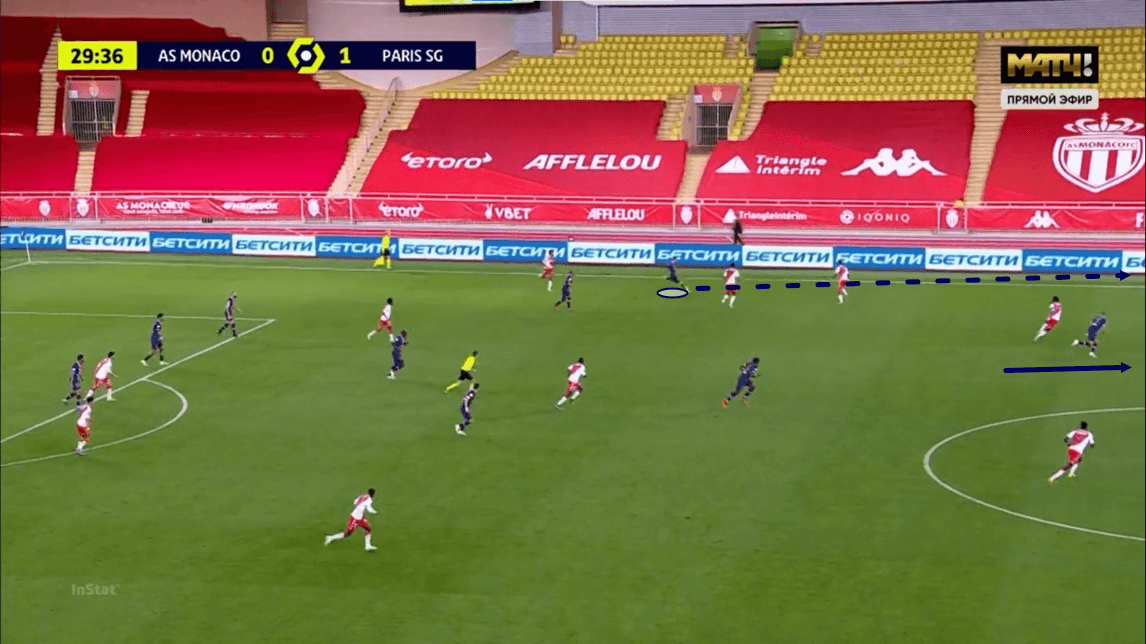
Secondly, PSG were very dangerous on the counter due to the pace of Mbappé and they made use of that tool effectively. One example of this can be seen in the image above. Here, we can see Sarabia on the ball deep and just before this image was taken, Les Parisiens won the ball back from Monaco.
Particularly in the first-half, there were times when Les Monéasques didn’t put a lot of pressure on PSG’s players just after they’d won the ball back and this allowed them to pick out long-balls over the top to Mbappé on the counter. This was one such occasion.
On top of that lack of counter-pressing intensity, Monaco played a high line and with Mbappé being the only PSG player staying high up the pitch, he managed to exploit the space in behind Monaco’s defensive line to great effect, with PSG’s first goal coming from a situation very similar to the one we can see in the image above.
So, long-balls were clearly a key part of PSG’s offensive tactics in this game due to their struggles to build out via short passes and the threat that the likes of Sarabia and Mbappé posed in different ways from these situations.
Monaco’s tactics on the ball
Monaco were more effective on the ball over the course of this game. With all of their goals coming in the second half, they did make some key tactical adjustments that helped them to turn this game around but firstly, we’re going to look at one particular tactic that they used to great effect throughout the entire 90 minutes.
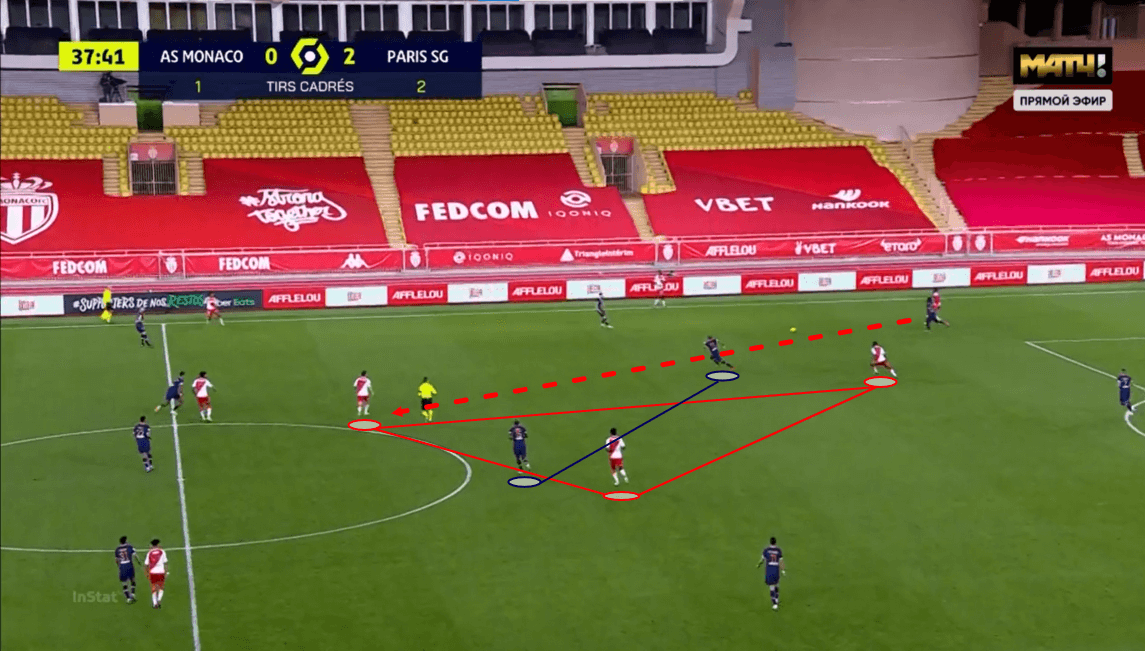
As we previously discussed, PSG’s midfielders marked Monaco’s midfielders tightly during the build-up. This is a regular tactic for PSG to deploy and Kovač’s side managed to exploit it very well throughout Friday’s fixture. We can see an example of how they managed to do this in the image above.
Here, we can see that Fofana has dropped deep during the build-up offering support to the centre-backs short, while Tchoueméni stayed a bit deeper. This pulls Rafinha out of position and creates space in behind him for the number ‘10’ Volland to drop into and exploit.
So, in addition to offering a short-passing option, Fofana created space for Volland to shift into and for his team to exploit. This pass from the Monaco centre-back to the number ‘10’ was a common pass for the home side to play throughout this game and it proved to be very effective for them.
Their manipulation of PSG’s midfielders and use of the number ‘10’ essentially allowed them to create a 3v2 advantage in midfield and always have a spare midfielder to build through.
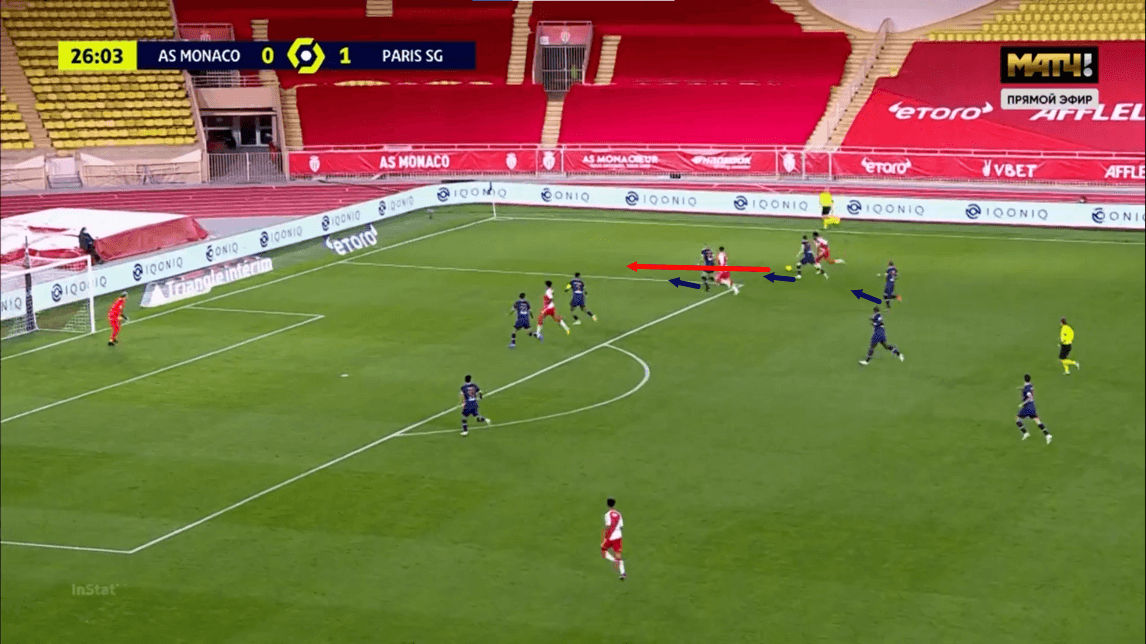
In the first half of the game, Monaco’s wingers usually dribbled out wide, carrying the ball towards the byline, however, this was often ineffective, as PSG would crowd around that wide man with two or three players who would prevent them from getting a cross in more often than not. This made it difficult for Monaco’s wingers to make much of an impact in the first half and they were often either dispossessed or forced to play a backpass to the full-back.
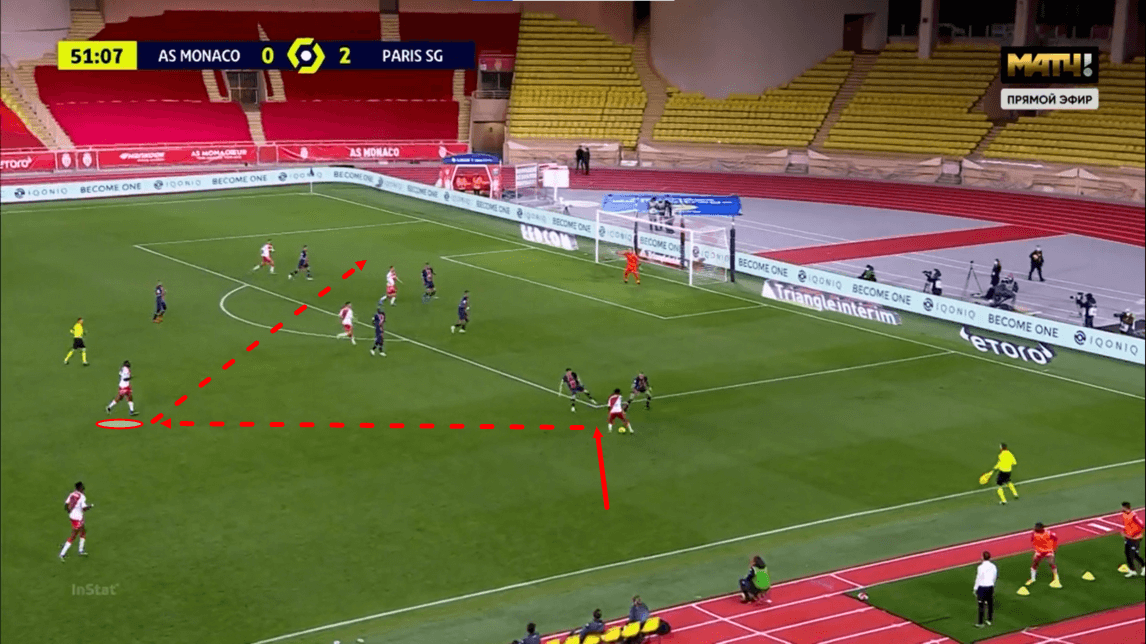
In the second half, Monaco’s wingers were more effective and one reason for this may be that instead of dribbling down the wing towards the byline, they dribbled inside more often, as we can see Martins doing here. This prevented PSG from being able to crowd around them as easily and helped the Monaco wide men to operate more effectively as creators.
Additionally, Monaco’s wide men enjoyed more support when carrying the ball this way. PSG’s midfield line and backline got very tight to one another when defending deep, as previously mentioned, and so this created space for Monaco’s central midfielders in a slightly deeper position.
The wingers often pulled the ball back to these central midfielders who usually played crosses into the box from these central positions. They generally targeted the back post and PSG’s full-backs via these crosses and they were successful in creating a goal via one move like this.
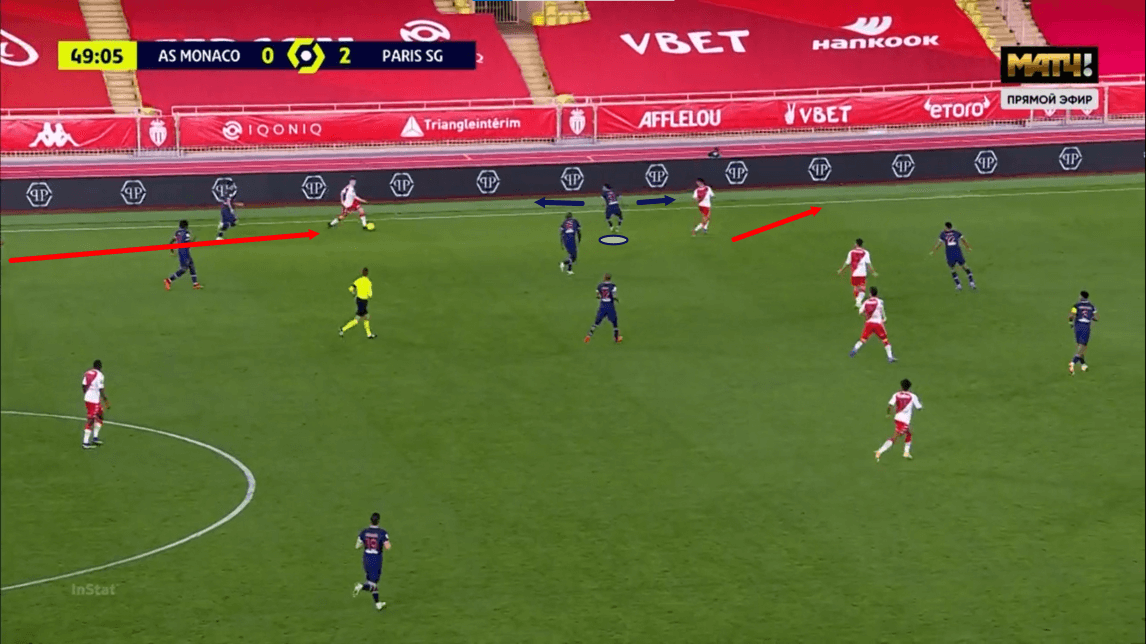
A couple of Monaco’s substitutions had a major impact on the game. Firstly, Henrique offered more going forward than Ballo-Touré did at left-back in this game when the Brazilian replaced him at half-time.
He carried the ball out from the back more often and this created a 2v1 situation in favour of the hosts as Henrique and Diop double-teamed Dagba, who can be seen in between the two players in this image above. As this passage of play moved on, Henrique and Diop played a one-two and got around the right-back, advancing into the final third.
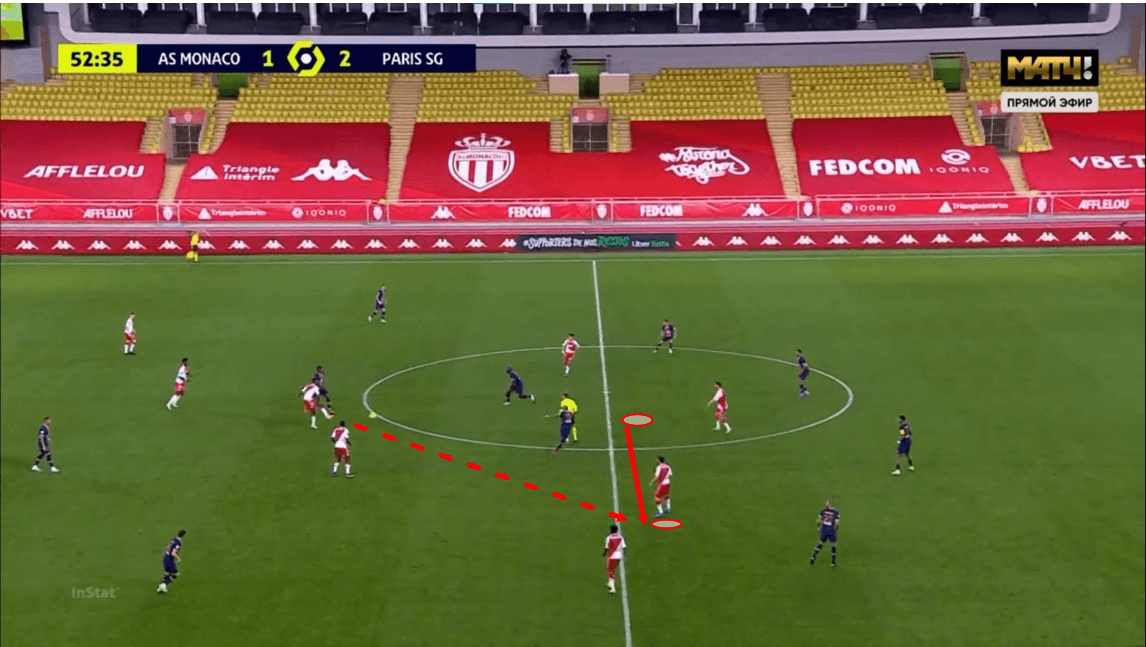
Secondly, Fàbregas was incredibly effective once he was introduced to the game as a ‘10’. The ex-Barcelona, Chelsea and Arsenal man was constantly moving around from the centre of the pitch to the left half-space and to the right half-space – which is where we see him here – finding space to exploit for his side.
Similarly to Volland, he often went unmarked and enjoyed plenty of freedom to exploit space in between the lines. The centre-backs played the ball straight to him often in the second half and he played a pivotal role in helping his side to build into the opposition half and the final third.
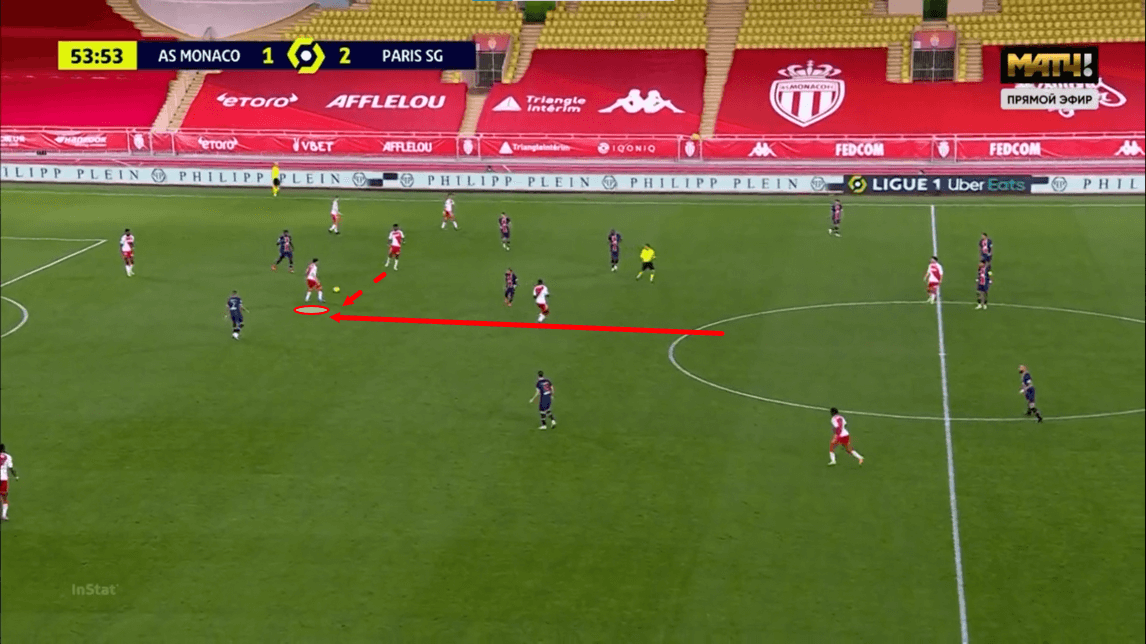
Fàbregas also dropped deep to help his side earlier on in the build-up at times in this game. Again, he would often find himself unmarked after dropping into positions like this, as PSG’s central midfielders were focused on Monaco’s central midfield duo, meaning that Fàbregas was essentially a spare man when he dropped deep.
While he usually provided more of an advantage to his side in the build-up via his movement further up the pitch, his long-ball-playing quality and vision came in useful in these situations where his team came under some pressure and struggled to build past PSG’s defensive shape, showing just how key the 2010 World Cup winner was in numerous ways following his introduction.
Conclusion
To conclude this tactical analysis piece, it’s clear that Monaco did well to stifle PSG during the build-up, as they limited their options realty when trying to play out from the back, while PSG failed to prevent Monaco from building through the centre due to the effectiveness of Les Monéasques’ use of the ‘10’.
Monaco’s second-half changes in tactics and personnel evidently worked and had a major positive impact for them in this one and helped them to take all three points.





Comments